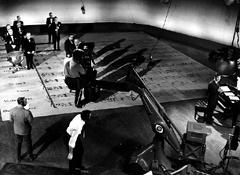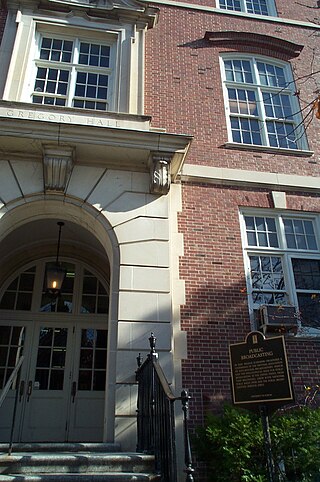Related Research Articles
Gunsmoke is an American radio and television Western drama series created by director Norman Macdonnell and writer John Meston. It centers on Dodge City, Kansas, in the 1870s, during the settlement of the American West. The central character is lawman Marshal Matt Dillon, played by William Conrad on radio and James Arness on television.

National Educational Television (NET) was an American educational broadcast television network owned by the Ford Foundation and later co-owned by the Corporation for Public Broadcasting. It operated from May 16, 1954 to October 4, 1970, and was succeeded by the Public Broadcasting Service (PBS), which has memberships with many television stations that were formerly part of NET.
Broadcast syndication is the practice of leasing the right to broadcasting television shows and radio programs to multiple television stations and radio stations, without going through a broadcast network. It is common in the United States where broadcast programming is scheduled by television networks with local independent affiliates. Syndication is less widespread in the rest of the world, as most countries have centralized networks or television stations without local affiliates. Shows can be syndicated internationally, although this is less common.
WNET, branded on-air as "Thirteen", is a primary PBS member television station licensed to Newark, New Jersey, United States, serving the New York City area. Owned by The WNET Group, it is a sister station to the area's secondary PBS member, Garden City, New York–licensed WLIW, and two class A stations which share spectrum with WNET: WNDT-CD and WMBQ-CD ; through an outsourcing agreement, The WNET Group also operates New Jersey's PBS state network NJ PBS and the website NJ Spotlight.

WGBH-TV, branded on-air as GBH or GBH 2 since 2020, is the primary PBS member television station in Boston, Massachusetts, United States. It is the flagship property of the WGBH Educational Foundation, which also owns Boston's secondary PBS member WGBX-TV and Springfield, Massachusetts PBS member WGBY-TV, Class A Biz TV affiliate WFXZ-CD and public radio stations WGBH and WCRB in the Boston area, and WCAI radio on Cape Cod. WGBH-TV also effectively, but unofficially serves as one of three flagship stations of PBS, along with WNET in New York City and WETA-TV in Washington, D.C.

Television is one of the major mass media outlets in the United States. As of 2011, household ownership of television sets in the country is 96.7%, with approximately 114,200,000 American households owning at least one television set as of August 2013. The majority of households have more than one set. The peak ownership percentage of households with at least one television set occurred during the 1996–97 season, with 98.4% ownership. In 1948, 1 percent of U.S. households owned at least one television while 75 percent did by 1955, and by 1992, 60 percent of all U.S. households received cable television subscriptions.
The following is the 1967–68 network television schedule for the three major English language commercial broadcast networks in the United States. The schedule covers primetime hours from September 1967 through August 1968. The schedule is followed by a list per network of returning series, new series, and series cancelled after the 1966–67 season.

Kukla, Fran and Ollie is an early American television show using puppets. It was created for children, but was soon watched by more adults than children. It did not have a script and was entirely ad-libbed. It was broadcast from Chicago between October 13, 1947 and August 30, 1957. Comedienne Fran Allison starred, interacting with puppets, Kukla and Ollie whose puppeteer was the show's creator, Burr Tillstrom. After the original run, the team appeared in other productions over several decades.
WYES-TV is a PBS member television station in New Orleans, Louisiana, United States, owned by the Greater New Orleans Educational Television Foundation. The station's studios are located on Navarre Avenue in the city's Navarre neighborhood, and its transmitter is located on Magistrate Street in Chalmette.
Arkansas PBS is a state network of PBS member television stations serving the U.S. state of Arkansas. It is operated by the Arkansas Educational Television Commission, a statutory non-cabinet agency of the Arkansas government operated through the Arkansas Department of Elementary and Secondary Education, which holds the licenses for all of the public television stations based in the state. The commission is managed by an independent board of university and education officials, and gubernatorial appointees representing each of Arkansas's four congressional districts. Along with offering television programs supplied by PBS and various independent distributors, the network produces public affairs, cultural and documentary programming as well as sports events sanctioned by the Arkansas Activities Association (AAA).
The Oklahoma Educational Television Authority (OETA) is a state network of PBS member television stations serving the U.S. state of Oklahoma. The authority operates as a statutory corporation that holds the licenses for all of the PBS stations operating in the state; it is managed by an independent board of gubernatorial appointees, and university and education officials, which is linked to the executive branch of the Oklahoma state government through the Secretary of Education.

Omnibus was an American, commercially sponsored, educational variety television series.
The 1947–48 United States network television schedule was nominally from September 1947 to March 1948, but scheduling ideas were still being worked out and did not follow modern standards. The schedule is followed by a list per network of returning series, new series, and series cancelled after the 1946–47 season.

A television show – or simply TV show – is the general reference to any content produced for viewing on a television set which is broadcast via over-the-air, satellite, or cable, This includes content made by television broadcasters and content made for broadcasting by film production companies. It excludes breaking news, advertisements, or trailers that are typically placed between shows. Television shows are most often scheduled for broadcast well ahead of time and appear on electronic guides or other TV listings, but streaming services often make them available for viewing anytime. The content in a television show is produced by one of two production methodologies, live taped shows such as variety and news magazine shows shot on a television studio stage or sporting events The other production model includes animation and the variety of film productions ranging from movies to series. Shows not produced on a television studio stage are usually contracted or licensed to be made by appropriate production companies.

Lost television broadcasts are mostly those early television programs which cannot be accounted for in studio archives usually because of deliberate destruction or neglect.

The Public Broadcasting Service (PBS) is an American public broadcaster and non-commercial, free-to-air television network based in Arlington, Virginia. PBS is a publicly funded nonprofit organization and the most prominent provider of educational programming to public television stations in the United States, distributing shows such as Frontline, Nova, PBS NewsHour, Arthur, Sesame Street, and This Old House.
The American Archive of Public Broadcasting (AAPB) is a collaboration between the Library of Congress and WGBH Educational Foundation, founded through the efforts of the Corporation for Public Broadcasting. The AAPB is a national effort to digitally preserve and make accessible historically significant public radio and television programs created over the past 70+ years. The archive comprises over 120 collections from contributing stations and original producers from US states and territories. As of April 2020, the collection includes nearly 113,000 digitized items preserved on-site at the Library of Congress, and 53,000 items in the collection are streaming online in the AAPB Online Reading Room.

In the United States, other than a few direct services, public broadcasting is almost entirely decentralized and is not operated by the government, but does receive some government support.
The Kentucky Channel, also known by its Program and System Information Protocol short name and on-screen logo bug as KET KY, is a full-time 24/7 statewide digital television programming service originating from PBS member state-network Kentucky Educational Television. The channel features programming related to the U.S. state of Kentucky, as well as coverage of Kentucky General Assembly when it is in session.
References
- ↑ "History of Public Broadcasting" . Retrieved 28 April 2011.
- ↑ Sterling, Kittross, Christoper, John (1990). Stay Tuned: A Concise History of American Broadcasting. Wadsworth Publishing Company. p. 389. ISBN 0-534-11905-0.
- 1 2 "PBL (Public Broadcast Laboratory)" . Retrieved 24 January 2016.
- ↑ "Public Broadcasting Service Donates TV Archives to Library of Congress" . Retrieved 24 January 2016.
- ↑ "American Archive of Public Broadcasting Search Results". americanarchive.org. Retrieved 2020-10-05.